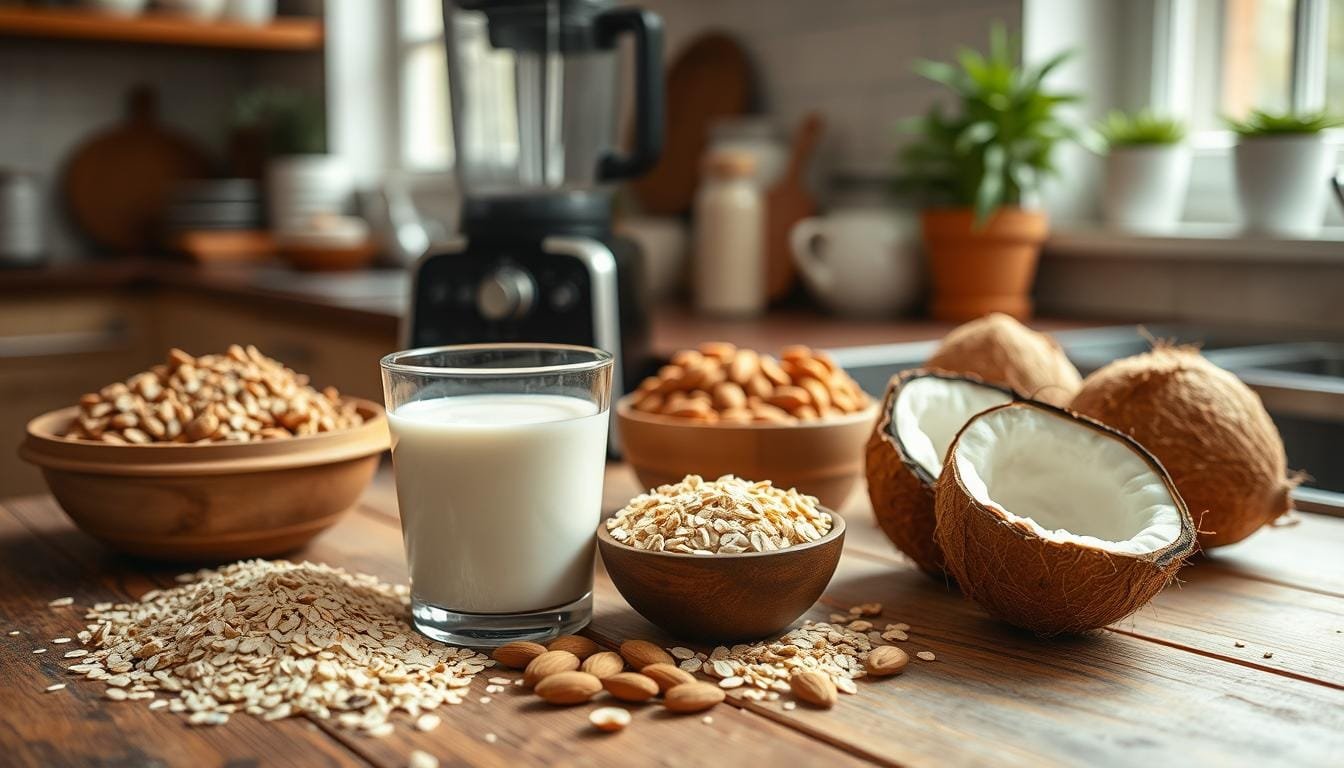I’m excited to share how to make delicious homemade vegan milk. Plant-based milks are popular as dairy-free options. You can choose from nut milk, seed milk, and more. Making your own milk lets you control the ingredients and texture, ensuring it’s fresh and free from additives.
Making homemade plant-based milk is easy and rewarding. First, soak the nuts, seeds, or grains. Then, blend them with water and strain to get the right consistency. You can also add sweeteners, spices, or superfoods to customize the flavor.
Learning to make plant-based milk at home is a big change. It’s great for health, the environment, or just wanting a natural option. In this guide, I’ll show you the equipment, ingredients, soaking methods, and how to make your own plant milk.
Understanding Plant-Based Milk Alternatives
The world of plant-based milk is growing fast. It offers health-conscious people many tasty and healthy choices. Options range from almond milk’s creamy taste to cashew’s nutty flavor. These alternatives are becoming more popular because of their benefits.
Benefits of Making Your Own Plant Milk
Homemade plant milk beats store-bought in many ways. You get freshness and control over what goes into it. Plus, you avoid preservatives and thickeners found in commercial milks. Making your own can also save money, making it a smart choice for your diet.
Store-Bought vs. Homemade Comparison
Commercial plant milks often have additives to last longer. Homemade milks, on the other hand, are free from these. They taste more authentic and are packed with more nutrients than store-bought ones.
Cost-Effectiveness of DIY Plant Milk
Making your own plant milk can save a lot of money. Buying nuts, seeds, and grains in bulk cuts down costs. This makes homemade plant milk a budget-friendly and healthy choice for many.
“Homemade plant-based milk not only tastes better, but it’s also a more budget-friendly and nutritious choice compared to store-bought options.”
Essential Equipment for Making Plant Milk
Making homemade plant-based milk is easy, but you need some basic tools. You’ll need a high-speed blender, a fine mesh nut milk bag, and glass jars for storing. Let’s dive into these must-have items.
A high-speed blender, like a Vitamix or Blendtec, is key. These blenders can easily grind nuts, seeds, or grains into smooth milk. If you don’t have one, a bullet-style blender can work too, but it might take more time and effort.
Then, a nut milk bag is vital for straining the milk. It lets you get rid of pulp or fiber, leaving you with smooth milk. You can also use cheesecloth, but a nut milk bag is better because it’s durable and reusable.
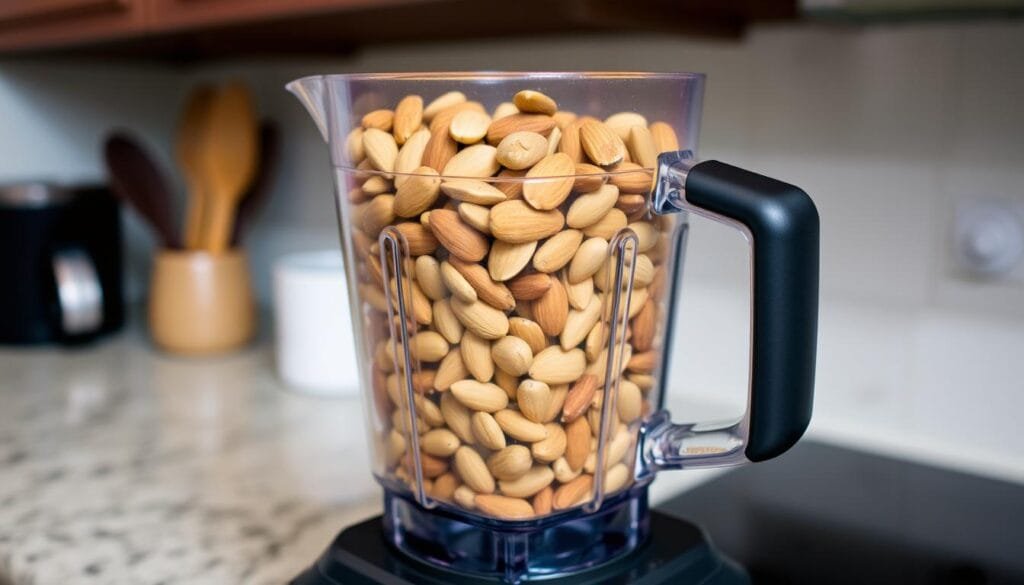
Lastly, you’ll need clean, sealable glass jars for storing your milk. These jars keep your milk fresh and flavorful for days. Glass is best for storing milk because it doesn’t pick up odors or tastes.
With these plant milk tools, you’re ready to make delicious, healthy plant-based milk at home. A bit of effort and the right tools will let you enjoy fresh, homemade milk without the need for store-bought options.
Best Nuts and Seeds for Homemade Plant-Based Milk
Choosing the right nuts and seeds is key to making delicious homemade plant-based milk. From creamy almond milk to nutty sunflower seed milk, there’s a lot to try. Let’s look at some top choices to make your plant-based milk even better.
Popular Nut Options
- Almonds: Known for their mild flavor and creamy texture, almonds are a favorite. They cost about $1.90 per 1/4 cup of organic, raw, and unsalted almonds.
- Cashews: These nuts offer a smooth and versatile base. High-quality, unroasted cashews cost around $1.60 per 1/4 cup.
- Hazelnuts: Hazelnuts add a nutty and earthy flavor to plant milk. They cost about $1.80 per 1/4 cup.
- Macadamia Nuts: For a luxurious taste, macadamia nuts provide a rich, creamy texture. They are a bit pricier, at around $2.50 per 1/4 cup.
Seed Alternatives for Nut-Free Milk
If you want to avoid nuts, seeds are great alternatives. Here are some top picks:
- Hemp Seeds: Hemp seeds have a subtle nutty flavor and a creamy texture. They cost about $1.20 per 1/4 cup.
- Sunflower Seeds: Sunflower seeds are a budget-friendly option. They yield a delicate, slightly sweet milk at just $0.35 per 1/4 cup.
- Pumpkin Seeds: Also known as pepitas, pumpkin seeds can be blended with other nuts for a nutrient-rich plant milk.
Cost Comparison of Different Ingredients
Understanding the cost differences between nuts and seeds is helpful for making homemade plant-based milk. Here’s a quick comparison:
| Ingredient | Cost per 1/4 cup |
|---|---|
| Almonds | $1.90 |
| Cashews | $1.60 |
| Hemp Seeds | $1.20 |
| Sunflower Seeds | $0.35 |
By trying different nuts and seeds, you can make a variety of tasty and affordable plant-based milks. Happy blending!
The Soaking Process: Times and Techniques
Soaking nuts and seeds is key to making tasty, healthy plant-based milk at home. It breaks down tough compounds and makes nutrients easier to use by your body.
Soaking times vary by nut or seed type. Almonds need 12 hours, cashews about 4 hours, and sunflower seeds 8 hours. Soaking helps your plant milk be creamier, even if you use a high-speed blender.
To soak, put nuts or seeds in a glass, cover with water, and chill. After soaking, rinse them well to get rid of extra water and dirt.
Hemp hearts are different. They don’t need soaking before blending. Their softness makes them blend into creamy, nutritious milk easily.
“Soaking nuts and seeds is a game-changer for homemade plant-based milk. It unlocks a world of creamier, more flavorful, and nutrient-dense options.”
Knowing the best soaking times and methods lets you make perfect plant milk every time. Enjoy your homemade milk’s great taste and texture.
Basic Steps to Make Plant-Based Milk at Home
Making homemade plant-based milk is simple. Just follow a few easy steps to create creamy, nutritious milk alternatives in your kitchen. You can use almonds, cashews, oats, or even bananas.
Preparation Methods
Begin by soaking your chosen nuts, seeds, or grains for at least 8 hours. Or, use a quick soak in hot water for 30 minutes. This makes them blend better.
After soaking, drain and rinse them well.
Blending Techniques
In a high-powered blender, mix 1/2 cup of soaked ingredients with 4 cups of water. Blend on high for about 90 seconds until it’s smooth. You can add salt and sweeteners or flavorings at this point.
Straining Guidelines
To get a creamier texture, strain the blend through a nut milk bag or cheesecloth. This is optional for smooth ingredients like cashews and hemp seeds. Adjust the nut-to-water ratio for the right thickness. A 1/4 cup of nuts per 4 cups of water makes a thinner milk, while 1 cup of nuts makes it richer.
Keep your homemade plant-based milk in airtight glass containers in the fridge for up to 4 days. Enjoy it in your favorite recipes and drinks!
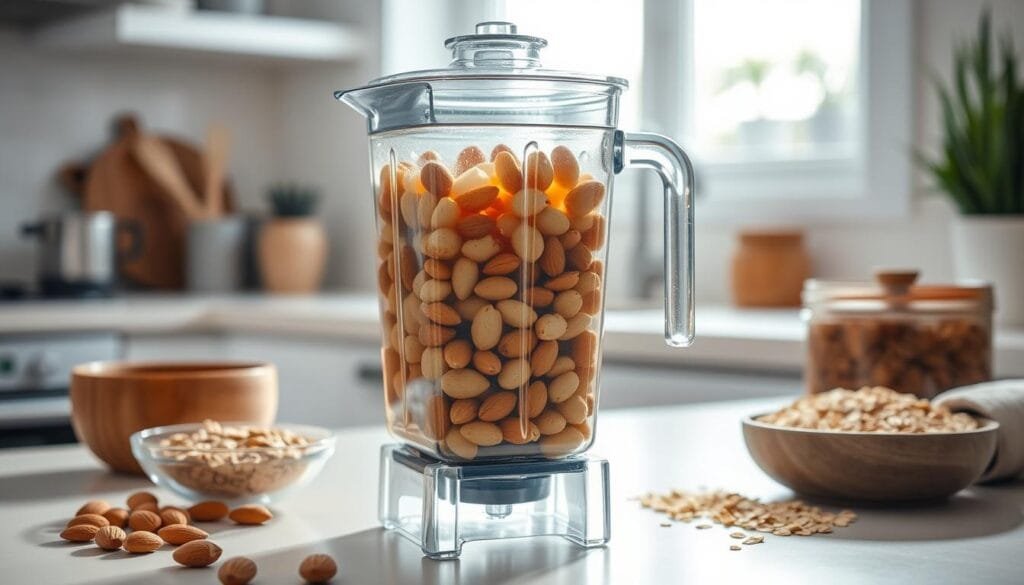
“Homemade plant milk provides a clean, fresh result as users know exactly what ingredients are used.”
Flavor Enhancement and Sweetening Options
Make your homemade plant-based milks taste better by trying different natural sweeteners and flavor boosters. You can use warm spices or rich extracts to make your own unique flavors.
Try using natural sweeteners like dates, maple syrup, or stevia. They add sweetness without the refined sugars found in store-bought milks. For creamier texture, add a bit of coconut butter or lecithin.
- Vanilla extract: Add a few drops to enhance the overall flavor profile.
- Raw cacao powder: Sprinkle in for a delightful chocolate twist.
- Cinnamon or nutmeg: These warming spices complement many plant milk flavors.
Don’t be afraid to mix and match flavors, like almond-vanilla or chocolate-hazelnut. Start with a little and add more until it tastes just right. Making your own plant milks lets you tailor them to your liking.
| Flavor Enhancer | Benefits |
|---|---|
| Dates | Natural sweetener, rich in fiber and antioxidants |
| Maple Syrup | Provides a subtle, caramelized sweetness |
| Stevia | Zero-calorie, plant-based sweetener |
| Vanilla Extract | Enhances the overall flavor profile |
| Raw Cacao Powder | Adds a delicious chocolate flavor |
By trying out these sweeteners and flavor boosters, you can make homemade plant milks that are truly special. They will make your cooking and baking even more enjoyable.
Storage Tips and Shelf Life
Keeping your homemade plant-based milk fresh and tasty is key. To make your homemade plant milk last longer, just follow these easy tips.
Container Recommendations
Keep your plant milk in clean, airtight glass jars or BPA-free plastic containers. Don’t use metal lids as they can rust. Instead, go for plastic lids for a tighter seal to keep air out and the milk fresh.
Proper Refrigeration Methods
- Put your homemade plant-based milk in the fridge right after making it. This slows down bacteria growth and keeps it fresh longer.
- Homemade plant milk usually stays good for 4-5 days in the fridge at 32°F (0°C) to 40°F (4°C).
- Always shake the milk well before using it. Separation is normal and doesn’t mean it’s spoiled.
- To store it longer, freeze extra plant milk in ice cube trays or silicone molds. Thaw frozen cubes in the fridge overnight before using.
By using these simple storage and fridge tips, you can enjoy your homemade plant milk for more days. It stays tasty and full of nutrients.
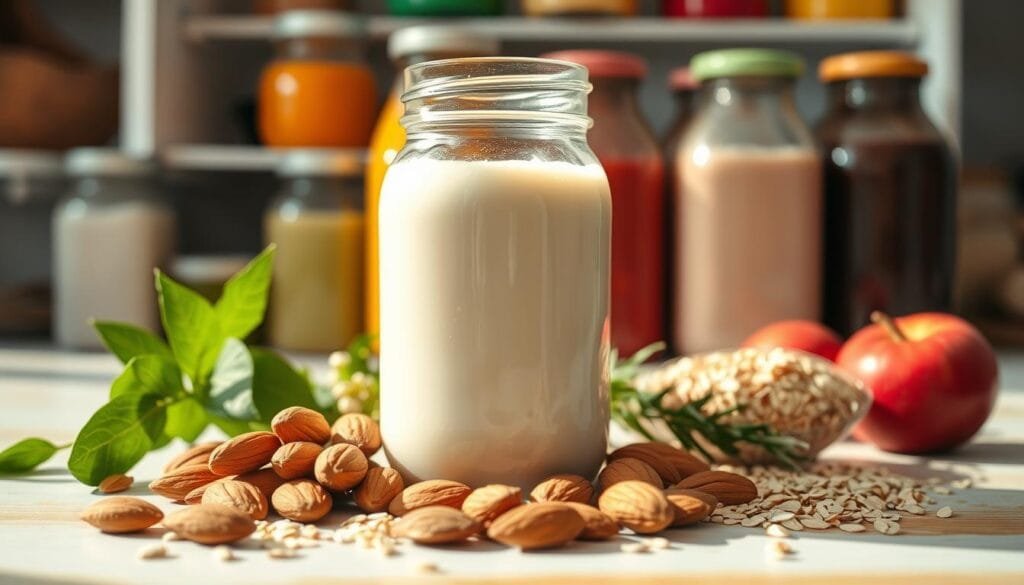
“Proper storage and refrigeration are key to maintaining the freshness and flavor of your homemade plant-based milk. With a few easy steps, you can extend the shelf life and savor your creations for days to come.”
Creamy Texture Guide and Ratios
The secret to perfect creamy plant-based milk is in the nut-to-water ratio. Adjusting this formula lets you create various textures. You can find the perfect consistency for your taste and recipes.
For a creamy drink, use 1/2 cup of nuts to 4 cups of water. This makes a smooth milk perfect for drinking or recipes.
For a thinner milk, try 1/4 cup of nuts to 4 cups of water. It’s great for cereal, baking, or making drinks thinner.
For a rich, creamy milk like heavy cream, use 2 cups of nuts to 4 cups of water. It’s perfect for sauces, soups, and desserts.
The type of nut or seed affects the milk’s texture. Creamier nuts like cashews and pecans make a richer milk. Almonds and hazelnuts might make a grainier milk.
Straining also changes the milk’s texture. Unstrained milk is thicker and textured. Straining through a fine-mesh bag makes it smoother.
| Nut-to-Water Ratio | Resulting Texture |
|---|---|
| 1/4 cup nuts to 4 cups water | Thin, watery consistency |
| 1/2 cup nuts to 4 cups water | Creamy, drinkable texture |
| 1 cup nuts to 4 cups water | Thick, creamy milk for recipes |
| 2 cups nuts to 4 cups water | Ultra-creamy, heavy cream-like |
Try different nut-to-water ratios to make various creamy non-dairy milk textures. This way, you can find the perfect milk for your needs and taste.
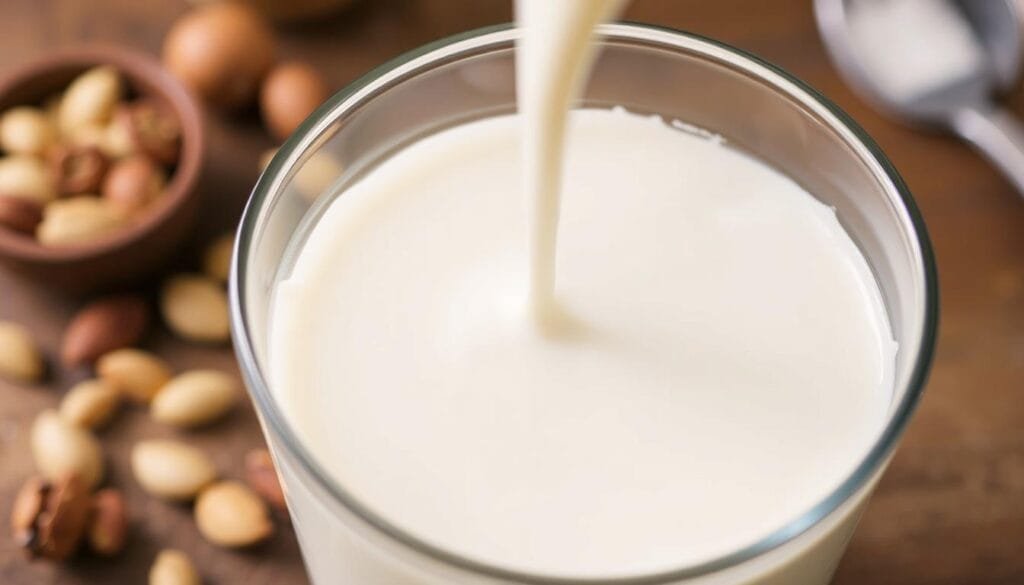
Creative Ways to Use Plant Milk Pulp
When you make plant-based milks at home, you might have leftover pulp. Instead of throwing it away, why not find new uses for it? You can use it in baking, skincare, and more. The nut milk pulp recipes offer endless possibilities.
Adding leftover plant milk solids to baked goods is easy. You can mix it into cookies, muffins, or even pie crusts. It adds fiber and texture. For a zero-waste option, blend it with oats, nuts, and a bit of sweetener to make granola or energy bars.
Want to get creative in the kitchen? Use the nut milk pulp recipes to make plant-based burgers or meatballs. The pulp adds a nutty flavor and extra fiber. You can also add it to smoothies or oatmeal for a nutritional boost.
But plant milk pulp isn’t just for cooking. It’s also great for self-care. Mix it with coconut oil to make a body scrub that exfoliates and moisturizes. Dehydrate it and use it in homemade face masks or soaps.
If you have too much nut milk pulp recipes, don’t waste it. Get creative and find ways to use it in your daily life. From baking to skincare, there are countless ways to use leftover plant milk solids.
“Reducing food waste is one of the most impactful ways we can positively contribute to the health of our planet.”
Troubleshooting Common Issues
Making homemade plant-based milk can be rewarding, but you might face some issues. Don’t worry, I’ve got tips to help you fix these problems. This way, you can make the perfect dairy-free drink at home.
If your plant milk separates, just shake it well before using. This is normal and doesn’t mean it’s spoiled. For thinner milk, use more nuts or seeds or less water. If it’s too thick, add a bit more water for creaminess.
If your milk feels gritty, strain it more. Use a finer mesh bag or cheesecloth to get rid of pulp. Always clean and sterilize your equipment to avoid spoilage. If your milk tastes bitter, try soaking the nuts for less time or lightly toast them before blending.
FAQ
What are the benefits of making your own plant-based milk?
How is the cost-effectiveness of DIY plant milk compared to store-bought?
What essential equipment is needed for making plant-based milk at home?
What are the best nuts and seeds to use for homemade plant-based milk?
FAQ
What are the benefits of making your own plant-based milk?
Making your own plant milk is nutritious and fresh. You can choose the ingredients, sugar, and texture. Store-bought milk often has additives and preservatives.
How is the cost-effectiveness of DIY plant milk compared to store-bought?
DIY plant milk can save money, using cheaper ingredients like sunflower seeds. It tastes better and is more nutritious than store-bought. But, it lasts shorter.
What essential equipment is needed for making plant-based milk at home?
You’ll need a high-speed blender, a nut milk bag, and glass jars. A bullet blender is an alternative. Cheesecloth can replace the nut milk bag.
What are the best nuts and seeds to use for homemade plant-based milk?
Almonds, cashews, hazelnuts, and macadamia nuts are good choices. Sunflower, hemp, and pumpkin seeds are also great. Almonds are
FAQ
What are the benefits of making your own plant-based milk?
Making your own plant milk is nutritious and fresh. You can choose the ingredients, sugar, and texture. Store-bought milk often has additives and preservatives.
How is the cost-effectiveness of DIY plant milk compared to store-bought?
DIY plant milk can save money, using cheaper ingredients like sunflower seeds. It tastes better and is more nutritious than store-bought. But, it lasts shorter.
What essential equipment is needed for making plant-based milk at home?
You’ll need a high-speed blender, a nut milk bag, and glass jars. A bullet blender is an alternative. Cheesecloth can replace the nut milk bag.
What are the best nuts and seeds to use for homemade plant-based milk?
Almonds, cashews, hazelnuts, and macadamia nuts are good choices. Sunflower, hemp, and pumpkin seeds are also great. Almonds are $1.90 per 1/4 cup, while sunflower seeds are $0.35.
How does the soaking process work for nuts and seeds used in plant milk?
Soaking breaks down hard compounds and boosts nutrients. Soak almonds for 12 hours, cashews for 4 hours, and sunflower seeds for 8 hours. Soaking is optional but improves texture.
What are the basic steps for making plant-based milk at home?
Soak ingredients if you want. Blend 1/2 cup nuts/seeds with 4 cups water for 90 seconds. Add salt and sweeteners or flavors. Strain for a smoother texture. Store in glass containers.
How can I enhance the flavor of homemade plant milk?
Use natural sweeteners like dates or maple syrup. Add vanilla, raw cacao, or spices. For creaminess, add coconut butter or lecithin. Try almond-vanilla or chocolate-hazelnut flavors.
How long does homemade plant milk last and how should it be stored?
Store it in sealed glass jars in the fridge. It lasts 4-5 days. Shake before use. Freeze excess in ice cube trays for later.
How can I adjust the creaminess of my homemade plant milk?
Change the nut-to-water ratio for creaminess. Use 1/2 cup nuts for a thinner milk, 1 cup for creamier. Straining affects texture, with unstrained being thicker.
What can I do with the leftover nut or seed pulp from making plant milk?
Use it in baking or smoothies for extra fiber. Make a body scrub or dehydrate for recipes. Compost if not using.
How can I troubleshoot common issues with homemade plant milk?
Shake well for separation. Use more nuts for thin milk. Strain for grittiness. Keep equipment clean to avoid spoilage. Adjust flavors with natural sweeteners or spices.
.90 per 1/4 cup, while sunflower seeds are
FAQ
What are the benefits of making your own plant-based milk?
Making your own plant milk is nutritious and fresh. You can choose the ingredients, sugar, and texture. Store-bought milk often has additives and preservatives.
How is the cost-effectiveness of DIY plant milk compared to store-bought?
DIY plant milk can save money, using cheaper ingredients like sunflower seeds. It tastes better and is more nutritious than store-bought. But, it lasts shorter.
What essential equipment is needed for making plant-based milk at home?
You’ll need a high-speed blender, a nut milk bag, and glass jars. A bullet blender is an alternative. Cheesecloth can replace the nut milk bag.
What are the best nuts and seeds to use for homemade plant-based milk?
Almonds, cashews, hazelnuts, and macadamia nuts are good choices. Sunflower, hemp, and pumpkin seeds are also great. Almonds are $1.90 per 1/4 cup, while sunflower seeds are $0.35.
How does the soaking process work for nuts and seeds used in plant milk?
Soaking breaks down hard compounds and boosts nutrients. Soak almonds for 12 hours, cashews for 4 hours, and sunflower seeds for 8 hours. Soaking is optional but improves texture.
What are the basic steps for making plant-based milk at home?
Soak ingredients if you want. Blend 1/2 cup nuts/seeds with 4 cups water for 90 seconds. Add salt and sweeteners or flavors. Strain for a smoother texture. Store in glass containers.
How can I enhance the flavor of homemade plant milk?
Use natural sweeteners like dates or maple syrup. Add vanilla, raw cacao, or spices. For creaminess, add coconut butter or lecithin. Try almond-vanilla or chocolate-hazelnut flavors.
How long does homemade plant milk last and how should it be stored?
Store it in sealed glass jars in the fridge. It lasts 4-5 days. Shake before use. Freeze excess in ice cube trays for later.
How can I adjust the creaminess of my homemade plant milk?
Change the nut-to-water ratio for creaminess. Use 1/2 cup nuts for a thinner milk, 1 cup for creamier. Straining affects texture, with unstrained being thicker.
What can I do with the leftover nut or seed pulp from making plant milk?
Use it in baking or smoothies for extra fiber. Make a body scrub or dehydrate for recipes. Compost if not using.
How can I troubleshoot common issues with homemade plant milk?
Shake well for separation. Use more nuts for thin milk. Strain for grittiness. Keep equipment clean to avoid spoilage. Adjust flavors with natural sweeteners or spices.
FAQ
What are the benefits of making your own plant-based milk?
Making your own plant milk is nutritious and fresh. You can choose the ingredients, sugar, and texture. Store-bought milk often has additives and preservatives.
How is the cost-effectiveness of DIY plant milk compared to store-bought?
DIY plant milk can save money, using cheaper ingredients like sunflower seeds. It tastes better and is more nutritious than store-bought. But, it lasts shorter.
What essential equipment is needed for making plant-based milk at home?
You’ll need a high-speed blender, a nut milk bag, and glass jars. A bullet blender is an alternative. Cheesecloth can replace the nut milk bag.
What are the best nuts and seeds to use for homemade plant-based milk?
Almonds, cashews, hazelnuts, and macadamia nuts are good choices. Sunflower, hemp, and pumpkin seeds are also great. Almonds are
FAQ
What are the benefits of making your own plant-based milk?
Making your own plant milk is nutritious and fresh. You can choose the ingredients, sugar, and texture. Store-bought milk often has additives and preservatives.
How is the cost-effectiveness of DIY plant milk compared to store-bought?
DIY plant milk can save money, using cheaper ingredients like sunflower seeds. It tastes better and is more nutritious than store-bought. But, it lasts shorter.
What essential equipment is needed for making plant-based milk at home?
You’ll need a high-speed blender, a nut milk bag, and glass jars. A bullet blender is an alternative. Cheesecloth can replace the nut milk bag.
What are the best nuts and seeds to use for homemade plant-based milk?
Almonds, cashews, hazelnuts, and macadamia nuts are good choices. Sunflower, hemp, and pumpkin seeds are also great. Almonds are $1.90 per 1/4 cup, while sunflower seeds are $0.35.
How does the soaking process work for nuts and seeds used in plant milk?
Soaking breaks down hard compounds and boosts nutrients. Soak almonds for 12 hours, cashews for 4 hours, and sunflower seeds for 8 hours. Soaking is optional but improves texture.
What are the basic steps for making plant-based milk at home?
Soak ingredients if you want. Blend 1/2 cup nuts/seeds with 4 cups water for 90 seconds. Add salt and sweeteners or flavors. Strain for a smoother texture. Store in glass containers.
How can I enhance the flavor of homemade plant milk?
Use natural sweeteners like dates or maple syrup. Add vanilla, raw cacao, or spices. For creaminess, add coconut butter or lecithin. Try almond-vanilla or chocolate-hazelnut flavors.
How long does homemade plant milk last and how should it be stored?
Store it in sealed glass jars in the fridge. It lasts 4-5 days. Shake before use. Freeze excess in ice cube trays for later.
How can I adjust the creaminess of my homemade plant milk?
Change the nut-to-water ratio for creaminess. Use 1/2 cup nuts for a thinner milk, 1 cup for creamier. Straining affects texture, with unstrained being thicker.
What can I do with the leftover nut or seed pulp from making plant milk?
Use it in baking or smoothies for extra fiber. Make a body scrub or dehydrate for recipes. Compost if not using.
How can I troubleshoot common issues with homemade plant milk?
Shake well for separation. Use more nuts for thin milk. Strain for grittiness. Keep equipment clean to avoid spoilage. Adjust flavors with natural sweeteners or spices.
.90 per 1/4 cup, while sunflower seeds are
FAQ
What are the benefits of making your own plant-based milk?
Making your own plant milk is nutritious and fresh. You can choose the ingredients, sugar, and texture. Store-bought milk often has additives and preservatives.
How is the cost-effectiveness of DIY plant milk compared to store-bought?
DIY plant milk can save money, using cheaper ingredients like sunflower seeds. It tastes better and is more nutritious than store-bought. But, it lasts shorter.
What essential equipment is needed for making plant-based milk at home?
You’ll need a high-speed blender, a nut milk bag, and glass jars. A bullet blender is an alternative. Cheesecloth can replace the nut milk bag.
What are the best nuts and seeds to use for homemade plant-based milk?
Almonds, cashews, hazelnuts, and macadamia nuts are good choices. Sunflower, hemp, and pumpkin seeds are also great. Almonds are $1.90 per 1/4 cup, while sunflower seeds are $0.35.
How does the soaking process work for nuts and seeds used in plant milk?
Soaking breaks down hard compounds and boosts nutrients. Soak almonds for 12 hours, cashews for 4 hours, and sunflower seeds for 8 hours. Soaking is optional but improves texture.
What are the basic steps for making plant-based milk at home?
Soak ingredients if you want. Blend 1/2 cup nuts/seeds with 4 cups water for 90 seconds. Add salt and sweeteners or flavors. Strain for a smoother texture. Store in glass containers.
How can I enhance the flavor of homemade plant milk?
Use natural sweeteners like dates or maple syrup. Add vanilla, raw cacao, or spices. For creaminess, add coconut butter or lecithin. Try almond-vanilla or chocolate-hazelnut flavors.
How long does homemade plant milk last and how should it be stored?
Store it in sealed glass jars in the fridge. It lasts 4-5 days. Shake before use. Freeze excess in ice cube trays for later.
How can I adjust the creaminess of my homemade plant milk?
Change the nut-to-water ratio for creaminess. Use 1/2 cup nuts for a thinner milk, 1 cup for creamier. Straining affects texture, with unstrained being thicker.
What can I do with the leftover nut or seed pulp from making plant milk?
Use it in baking or smoothies for extra fiber. Make a body scrub or dehydrate for recipes. Compost if not using.
How can I troubleshoot common issues with homemade plant milk?
Shake well for separation. Use more nuts for thin milk. Strain for grittiness. Keep equipment clean to avoid spoilage. Adjust flavors with natural sweeteners or spices.
FAQ
What are the benefits of making your own plant-based milk?
Making your own plant milk is nutritious and fresh. You can choose the ingredients, sugar, and texture. Store-bought milk often has additives and preservatives.
How is the cost-effectiveness of DIY plant milk compared to store-bought?
DIY plant milk can save money, using cheaper ingredients like sunflower seeds. It tastes better and is more nutritious than store-bought. But, it lasts shorter.
What essential equipment is needed for making plant-based milk at home?
You’ll need a high-speed blender, a nut milk bag, and glass jars. A bullet blender is an alternative. Cheesecloth can replace the nut milk bag.
What are the best nuts and seeds to use for homemade plant-based milk?
Almonds, cashews, hazelnuts, and macadamia nuts are good choices. Sunflower, hemp, and pumpkin seeds are also great. Almonds are
FAQ
What are the benefits of making your own plant-based milk?
Making your own plant milk is nutritious and fresh. You can choose the ingredients, sugar, and texture. Store-bought milk often has additives and preservatives.
How is the cost-effectiveness of DIY plant milk compared to store-bought?
DIY plant milk can save money, using cheaper ingredients like sunflower seeds. It tastes better and is more nutritious than store-bought. But, it lasts shorter.
What essential equipment is needed for making plant-based milk at home?
You’ll need a high-speed blender, a nut milk bag, and glass jars. A bullet blender is an alternative. Cheesecloth can replace the nut milk bag.
What are the best nuts and seeds to use for homemade plant-based milk?
Almonds, cashews, hazelnuts, and macadamia nuts are good choices. Sunflower, hemp, and pumpkin seeds are also great. Almonds are $1.90 per 1/4 cup, while sunflower seeds are $0.35.
How does the soaking process work for nuts and seeds used in plant milk?
Soaking breaks down hard compounds and boosts nutrients. Soak almonds for 12 hours, cashews for 4 hours, and sunflower seeds for 8 hours. Soaking is optional but improves texture.
What are the basic steps for making plant-based milk at home?
Soak ingredients if you want. Blend 1/2 cup nuts/seeds with 4 cups water for 90 seconds. Add salt and sweeteners or flavors. Strain for a smoother texture. Store in glass containers.
How can I enhance the flavor of homemade plant milk?
Use natural sweeteners like dates or maple syrup. Add vanilla, raw cacao, or spices. For creaminess, add coconut butter or lecithin. Try almond-vanilla or chocolate-hazelnut flavors.
How long does homemade plant milk last and how should it be stored?
Store it in sealed glass jars in the fridge. It lasts 4-5 days. Shake before use. Freeze excess in ice cube trays for later.
How can I adjust the creaminess of my homemade plant milk?
Change the nut-to-water ratio for creaminess. Use 1/2 cup nuts for a thinner milk, 1 cup for creamier. Straining affects texture, with unstrained being thicker.
What can I do with the leftover nut or seed pulp from making plant milk?
Use it in baking or smoothies for extra fiber. Make a body scrub or dehydrate for recipes. Compost if not using.
How can I troubleshoot common issues with homemade plant milk?
Shake well for separation. Use more nuts for thin milk. Strain for grittiness. Keep equipment clean to avoid spoilage. Adjust flavors with natural sweeteners or spices.
.90 per 1/4 cup, while sunflower seeds are
FAQ
What are the benefits of making your own plant-based milk?
Making your own plant milk is nutritious and fresh. You can choose the ingredients, sugar, and texture. Store-bought milk often has additives and preservatives.
How is the cost-effectiveness of DIY plant milk compared to store-bought?
DIY plant milk can save money, using cheaper ingredients like sunflower seeds. It tastes better and is more nutritious than store-bought. But, it lasts shorter.
What essential equipment is needed for making plant-based milk at home?
You’ll need a high-speed blender, a nut milk bag, and glass jars. A bullet blender is an alternative. Cheesecloth can replace the nut milk bag.
What are the best nuts and seeds to use for homemade plant-based milk?
Almonds, cashews, hazelnuts, and macadamia nuts are good choices. Sunflower, hemp, and pumpkin seeds are also great. Almonds are $1.90 per 1/4 cup, while sunflower seeds are $0.35.
How does the soaking process work for nuts and seeds used in plant milk?
Soaking breaks down hard compounds and boosts nutrients. Soak almonds for 12 hours, cashews for 4 hours, and sunflower seeds for 8 hours. Soaking is optional but improves texture.
What are the basic steps for making plant-based milk at home?
Soak ingredients if you want. Blend 1/2 cup nuts/seeds with 4 cups water for 90 seconds. Add salt and sweeteners or flavors. Strain for a smoother texture. Store in glass containers.
How can I enhance the flavor of homemade plant milk?
Use natural sweeteners like dates or maple syrup. Add vanilla, raw cacao, or spices. For creaminess, add coconut butter or lecithin. Try almond-vanilla or chocolate-hazelnut flavors.
How long does homemade plant milk last and how should it be stored?
Store it in sealed glass jars in the fridge. It lasts 4-5 days. Shake before use. Freeze excess in ice cube trays for later.
How can I adjust the creaminess of my homemade plant milk?
Change the nut-to-water ratio for creaminess. Use 1/2 cup nuts for a thinner milk, 1 cup for creamier. Straining affects texture, with unstrained being thicker.
What can I do with the leftover nut or seed pulp from making plant milk?
Use it in baking or smoothies for extra fiber. Make a body scrub or dehydrate for recipes. Compost if not using.
How can I troubleshoot common issues with homemade plant milk?
Shake well for separation. Use more nuts for thin milk. Strain for grittiness. Keep equipment clean to avoid spoilage. Adjust flavors with natural sweeteners or spices.
FAQ
What are the benefits of making your own plant-based milk?
Making your own plant milk is nutritious and fresh. You can choose the ingredients, sugar, and texture. Store-bought milk often has additives and preservatives.
How is the cost-effectiveness of DIY plant milk compared to store-bought?
DIY plant milk can save money, using cheaper ingredients like sunflower seeds. It tastes better and is more nutritious than store-bought. But, it lasts shorter.
What essential equipment is needed for making plant-based milk at home?
You’ll need a high-speed blender, a nut milk bag, and glass jars. A bullet blender is an alternative. Cheesecloth can replace the nut milk bag.
What are the best nuts and seeds to use for homemade plant-based milk?
Almonds, cashews, hazelnuts, and macadamia nuts are good choices. Sunflower, hemp, and pumpkin seeds are also great. Almonds are
FAQ
What are the benefits of making your own plant-based milk?
Making your own plant milk is nutritious and fresh. You can choose the ingredients, sugar, and texture. Store-bought milk often has additives and preservatives.
How is the cost-effectiveness of DIY plant milk compared to store-bought?
DIY plant milk can save money, using cheaper ingredients like sunflower seeds. It tastes better and is more nutritious than store-bought. But, it lasts shorter.
What essential equipment is needed for making plant-based milk at home?
You’ll need a high-speed blender, a nut milk bag, and glass jars. A bullet blender is an alternative. Cheesecloth can replace the nut milk bag.
What are the best nuts and seeds to use for homemade plant-based milk?
Almonds, cashews, hazelnuts, and macadamia nuts are good choices. Sunflower, hemp, and pumpkin seeds are also great. Almonds are $1.90 per 1/4 cup, while sunflower seeds are $0.35.
How does the soaking process work for nuts and seeds used in plant milk?
Soaking breaks down hard compounds and boosts nutrients. Soak almonds for 12 hours, cashews for 4 hours, and sunflower seeds for 8 hours. Soaking is optional but improves texture.
What are the basic steps for making plant-based milk at home?
Soak ingredients if you want. Blend 1/2 cup nuts/seeds with 4 cups water for 90 seconds. Add salt and sweeteners or flavors. Strain for a smoother texture. Store in glass containers.
How can I enhance the flavor of homemade plant milk?
Use natural sweeteners like dates or maple syrup. Add vanilla, raw cacao, or spices. For creaminess, add coconut butter or lecithin. Try almond-vanilla or chocolate-hazelnut flavors.
How long does homemade plant milk last and how should it be stored?
Store it in sealed glass jars in the fridge. It lasts 4-5 days. Shake before use. Freeze excess in ice cube trays for later.
How can I adjust the creaminess of my homemade plant milk?
Change the nut-to-water ratio for creaminess. Use 1/2 cup nuts for a thinner milk, 1 cup for creamier. Straining affects texture, with unstrained being thicker.
What can I do with the leftover nut or seed pulp from making plant milk?
Use it in baking or smoothies for extra fiber. Make a body scrub or dehydrate for recipes. Compost if not using.
How can I troubleshoot common issues with homemade plant milk?
Shake well for separation. Use more nuts for thin milk. Strain for grittiness. Keep equipment clean to avoid spoilage. Adjust flavors with natural sweeteners or spices.
.90 per 1/4 cup, while sunflower seeds are
FAQ
What are the benefits of making your own plant-based milk?
Making your own plant milk is nutritious and fresh. You can choose the ingredients, sugar, and texture. Store-bought milk often has additives and preservatives.
How is the cost-effectiveness of DIY plant milk compared to store-bought?
DIY plant milk can save money, using cheaper ingredients like sunflower seeds. It tastes better and is more nutritious than store-bought. But, it lasts shorter.
What essential equipment is needed for making plant-based milk at home?
You’ll need a high-speed blender, a nut milk bag, and glass jars. A bullet blender is an alternative. Cheesecloth can replace the nut milk bag.
What are the best nuts and seeds to use for homemade plant-based milk?
Almonds, cashews, hazelnuts, and macadamia nuts are good choices. Sunflower, hemp, and pumpkin seeds are also great. Almonds are $1.90 per 1/4 cup, while sunflower seeds are $0.35.
How does the soaking process work for nuts and seeds used in plant milk?
Soaking breaks down hard compounds and boosts nutrients. Soak almonds for 12 hours, cashews for 4 hours, and sunflower seeds for 8 hours. Soaking is optional but improves texture.
What are the basic steps for making plant-based milk at home?
Soak ingredients if you want. Blend 1/2 cup nuts/seeds with 4 cups water for 90 seconds. Add salt and sweeteners or flavors. Strain for a smoother texture. Store in glass containers.
How can I enhance the flavor of homemade plant milk?
Use natural sweeteners like dates or maple syrup. Add vanilla, raw cacao, or spices. For creaminess, add coconut butter or lecithin. Try almond-vanilla or chocolate-hazelnut flavors.
How long does homemade plant milk last and how should it be stored?
Store it in sealed glass jars in the fridge. It lasts 4-5 days. Shake before use. Freeze excess in ice cube trays for later.
How can I adjust the creaminess of my homemade plant milk?
Change the nut-to-water ratio for creaminess. Use 1/2 cup nuts for a thinner milk, 1 cup for creamier. Straining affects texture, with unstrained being thicker.
What can I do with the leftover nut or seed pulp from making plant milk?
Use it in baking or smoothies for extra fiber. Make a body scrub or dehydrate for recipes. Compost if not using.
How can I troubleshoot common issues with homemade plant milk?
Shake well for separation. Use more nuts for thin milk. Strain for grittiness. Keep equipment clean to avoid spoilage. Adjust flavors with natural sweeteners or spices.
.35.
How does the soaking process work for nuts and seeds used in plant milk?
Soaking breaks down hard compounds and boosts nutrients. Soak almonds for 12 hours, cashews for 4 hours, and sunflower seeds for 8 hours. Soaking is optional but improves texture.
What are the basic steps for making plant-based milk at home?
Soak ingredients if you want. Blend 1/2 cup nuts/seeds with 4 cups water for 90 seconds. Add salt and sweeteners or flavors. Strain for a smoother texture. Store in glass containers.
How can I enhance the flavor of homemade plant milk?
Use natural sweeteners like dates or maple syrup. Add vanilla, raw cacao, or spices. For creaminess, add coconut butter or lecithin. Try almond-vanilla or chocolate-hazelnut flavors.
How long does homemade plant milk last and how should it be stored?
Store it in sealed glass jars in the fridge. It lasts 4-5 days. Shake before use. Freeze excess in ice cube trays for later.
How can I adjust the creaminess of my homemade plant milk?
Change the nut-to-water ratio for creaminess. Use 1/2 cup nuts for a thinner milk, 1 cup for creamier. Straining affects texture, with unstrained being thicker.
What can I do with the leftover nut or seed pulp from making plant milk?
Use it in baking or smoothies for extra fiber. Make a body scrub or dehydrate for recipes. Compost if not using.
How can I troubleshoot common issues with homemade plant milk?
Shake well for separation. Use more nuts for thin milk. Strain for grittiness. Keep equipment clean to avoid spoilage. Adjust flavors with natural sweeteners or spices.
